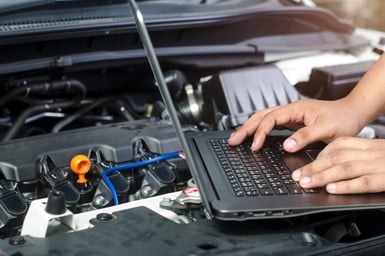What to Know When Servicing EPS Systems
 While many electronic power steering systems still involve hybrid technology that pumps hydraulic fluid to assist steering, the most cutting-edge EPS systems of today and tomorrow are fully electronic. This elimination of hydraulic parts in favor of electronic motors and sensors certainly changes your job as a repairer or rebuilder, and that's something you need to be prepared for.
While many electronic power steering systems still involve hybrid technology that pumps hydraulic fluid to assist steering, the most cutting-edge EPS systems of today and tomorrow are fully electronic. This elimination of hydraulic parts in favor of electronic motors and sensors certainly changes your job as a repairer or rebuilder, and that's something you need to be prepared for.
When power steering is all-electric, servicing EPS systems is completely different from servicing more traditional units. Keep reading to find out what really goes into servicing EPS systems moving forward.
Electronic Power Steering Parts
A fully electronic power steering system eliminates the need for physical pumps, hoses, and belts to drive power assist.
Instead, an EPS system is composed of four major parts:
- An EPS control module, which acts as the "brain" of the system, collecting data from the other components of the system and sending it out
- An EPS motor that powers the assistance function based on the information provided by the control module
- A reduction gear to input the power assist to the steering rack
- A torque sensor that collects driver input as well as the system's mechanical output using two coils that receive signals from the module when turning left or right.
While these changes in configuration provide benefits like improved fuel efficiency and continued power assist when the engine stalls, they also mean that technicians and rebuilders must learn how to identify and handle EPS parts. And as you'll read in the next segment of this post, the ways to troubleshoot, diagnose, and service EPS issues are equally digital.
Diagnosing Problems and Servicing EPS Systems
EPS systems deal with the transfer of information, which means that in order to service them, you must analyze that data and how it's being translated from one part to another. As you might imagine, that means diagnosing those problems often takes a more sophisticated approach because you can't always see the problem on the surface.
 Here's what you need to know about diagnosing electronic power steering issues:
Here's what you need to know about diagnosing electronic power steering issues:
- You'll need to run a diagnostic scan in order to understand where the electronic malfunction or failure is occurring.
- While most EPS technology includes built-in diagnostic capabilities, you'll need to use a scan tool that can return diagnostic trouble codes (DTCs) that identify the type and location of the problem. Codes begin with a letter that indicates the segment of the system affected, and the four digits that follow indicate the specific issue. (Note: Generic DTC codes may not apply to every vehicle.)
- Once you've completed your troubleshooting and identified the DTC, the methods to servicing or repairing EPS systems are usually electronic as well: positioning and calibration, module programming, electrical skills, and meter usage can all come into play.
Though there are hundreds of DTC codes that indicate a multitude of problems within EPS, you're likely to run into these common problems while servicing EPS systems and should be prepared for them. Here are a few common EPS issues:
- Alignment issues: While the wheel itself might be aligned, the EPS might be providing more assist to the right or left. This alignment issue is caused by an error in the zero position of the wheel, meaning that the ECU needs to know when no assist is needed. This calibration should be completed during different procedures such as wheel alignments or other part replacements.
- Increased steering effort/no assist: When a vehicle has apparently lost steering assist capability, a common culprit is the activation of EPS fail-safe technology intended to protect drivers, passengers, and the EPS system, but certain DTC's can trigger the fail-safe as well. The fail-safe mode will need to be reset in these cases.
- Issues with CAN communication: The CAN system is what allows the ECU to transmit data through the system, and issues with communication can create data-sharing issues in EPS. While it will probably take some special training to understand the inner workings of the CAN system, with more EPS on the road than ever, it's something your shop should be preparing for.
However, in addition to these common issues and many more, it is possible for a power steering complaint to return no DTC code. In these cases, it might be necessary for you to test drive the vehicle to understand what the customer is experiencing. Specific research on the make and model of the vehicle might reveal that the complaint is common to the application. Often, it's as simple as something that's out of calibration is causing a different "feel" to the driver.
In many ways, EPS systems are still very much an emerging technology in the automotive industry, and manufacturers, drivers, and rebuilders alike are still somewhere on the learning curve when it comes to their use and service. The best thing you can do for your shop is to prepare your team with the necessary information, techniques, and tools to help them service EPS systems now and in the future.


